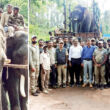
A Tiger Wedding in Coorg, India
From: The Illustrated London News
December 6, 1873
The small province of Coorg, in Southern India, is situated among the mountains that separate Mysore from the Malabar coast to the west. Its late Rajah, being of cruel and treacherous misrule, was deposed in 1834, and the Coorgs, being put to the vote, unanimously desired to become complete subjects of the British Government. In 1852, the deposed Rajah visited England, accompanied by his daughter Gauramma, and paid his former enemies the compliment of seeking for her an English and Christian education. In June 30, 1852, she was baptized, the Queen herself standing sponsor, and giving her the name ‘Victoria.’ The Princess Victorian Gauramma, who was a constant visitor to her Majesty at Osborne and Windsor, eventually married an English officer of the name of Campbell. She died in 1864; her tyrant father lies buried in the Kensal-green Cemetery.
A good description of Coorg will be found in ‘Eastern Experiences,’ by Mr. Lewin Bowring, late Resident or Governor of Mysore. The natives are distinguished for their fine appearance and warlike temper. They are skillful hunters, being trained for this from infancy; at the birth of a boy, the first thing done is to place a little bow and arrow in his hands, and to fire a gun outside the house, thus initiating his career as a huntsman and warrior.
In the accompanying illustration there is abundance of music, feasting, torchlight, and dancers; and the owner of the mansion is brought in with triumph to graces the festival.
A curious ceremony takes place when a tiger has been shot by a Coorg man. Tigers are not numerous in the country, and this ceremony has only occurred twice within the past four years. On the last occasion, March 9 of this year, the successful huntsman was Mr. Colovanda(Koluvanda) Carriapah(Cariappa), Head Sheristadar of the Mercara Talook. In this ceremony the man is wedded to the soul of the dead tiger.
As shown in the Illustration, he is seated under a canopy in full warrior costume. On each side are placed his weapons and the household emblems of plenty, vessels of rice and milk, and burning lamps, analogous to the Masonic corn, wine and oil. So he sits, receiving the homage and congratulations of his relatives and friends. Each scatters a few grains of rice over his head, and gives him a sip of milk from a brass vessel resembling a teapot, and makes an offering in money, varying in value according to the means of the donor. The hero of the day is afterwards carried in triumph round the tiger, which is suspended to a high bamboo grame in the garden. The officers and ladies of the regiment stationed at Mercara, who reside in the late Rajah’s palace, were specially invited to attend.
Mr. Carriapah is a native Coorg gentleman of high merit and distinction. He wears the gold Coorg medal, which was presented by the British Government to his father, for suppressing an insurrection in South Canara. Our correspondent would further testify to Mr. Carriapah’s unvarying support of English education among the Coorgs. A wealthy and influential man, he spares neither time nor money in this cause, and has, at his sole expense, erected schools for Coorg girls as well as boys, and has on several occasions received the thanks of the Government of India, as well as of the local Government of Mysore and Coorg.
We are indebted to Captain Belford Cummins, of the Staff Corps at Mercara, for the sketch we have engraved.
Update: We had mentioned the groom as Coravanda in the post. We have received an email stating that the groom was Coluvanda and not Coravanda. We have fact-checked and updated accordingly.






The Rajah of Coorg.. as mentioned in the first paragraph, is not buried in England. His body was brought back to Varanasi by his eldest son, Somshekara. He was buried at the Lingayat jangamwadi of Varanasi.